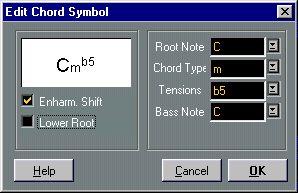Chord Symbols
Adding Chords
1. Select the Chord Tool.
 The Chord Tool.
The Chord Tool.
2. Click in the score, at the position where you want to insert a chord symbol (normally above the notes).
A dialog box opens where you can set a number of parameters:

Parameter Root Note Chord Type Tensions
Bass Note
Enharm. Shift Lower Root
Description
This is the actual key of the chord.
Allows you to select a type for the chord (minor, diminished, suspended, etc.). Allows you to add one or several tensions to the chord.
If the bass note should differ from the root note, you can specify the bass note here. For example, Root Note C and Bass Note D means a C chord with a D bass note. Activating this checkbox allows you to perform enharmonic shift on the chord. When this is activated, a lower case letter is used for the Root Key.
• Note that you can either use the pop-up menus or freely type in the desired notes, types and tensions.
The chord display to the left is automatically updated to show the current settings.
3. When you have set up the chord, click OK.
A chord symbol appears at the position where you clicked.
Editing chords
Once a chord is in place, you can edit it by double clicking it. A similar dialog box appears as when you created the chord. Change the settings and click OK.





